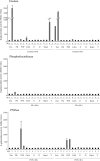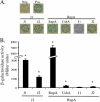Characterization of components of the Staphylococcus aureus mRNA degradosome holoenzyme-like complex
- PMID: 21764917
- PMCID: PMC3187390
- DOI: 10.1128/JB.05485-11
Characterization of components of the Staphylococcus aureus mRNA degradosome holoenzyme-like complex
Abstract
Bacterial two-hybrid analysis identified the Staphylococcus aureus RNA degradosome-like complex to include RNase J1, RNase J2, RNase Y, polynucleotide phosphorylase (PNPase), enolase, phosphofructokinase, and a DEAD box RNA helicase. Results also revealed that the recently recognized RNase RnpA interacts with the S. aureus degradosome and that this interaction is conserved in other Gram-positive organisms.
Figures






References
-
- Carpousis A. J. 2002. The Escherichia coli RNA degradosome: structure, function and relationship in other ribonucleolytic multienzyme complexes. Biochem. Soc. Trans. 30:150–155 - PubMed
-
- Carpousis A. J., Van Houwe G., Ehretsmann C., Krisch H. M. 1994. Copurification of E. coli RNase E and PNPase: evidence for a specific association between two enzymes important in RNA processing and degradation. Cell 76:889–900 - PubMed
-
- Chandran V., Luisi B. F. 2006. Recognition of enolase in the Escherichia coli RNA degradosome. J. Mol. Biol. 358:8–15 - PubMed
Publication types
MeSH terms
Substances
Grants and funding
LinkOut - more resources
Full Text Sources
Other Literature Sources
Molecular Biology Databases

